It is not an absolute necessity to attend the gym in order to effectively work the muscles of the legs and bring about significant changes in strength and fitness.
One of the most practical pieces of resistance that you have access to is your own bodyweight. The best part about bodyweight training is that workout can literally be performed anywhere with no need for additional equipment.
This article will provide 10 different leg workouts that can be performed at home to develop fitness and improve the strength and function of the glutes, hamstrings, quads, adductors, abductors, and calves.
Table of Contents
10 Home Based Leg Workouts
This section will break down the technique for each of the exercises that are used in the 10 workouts below to allow you to exercise safely and effectively.
1. Squats
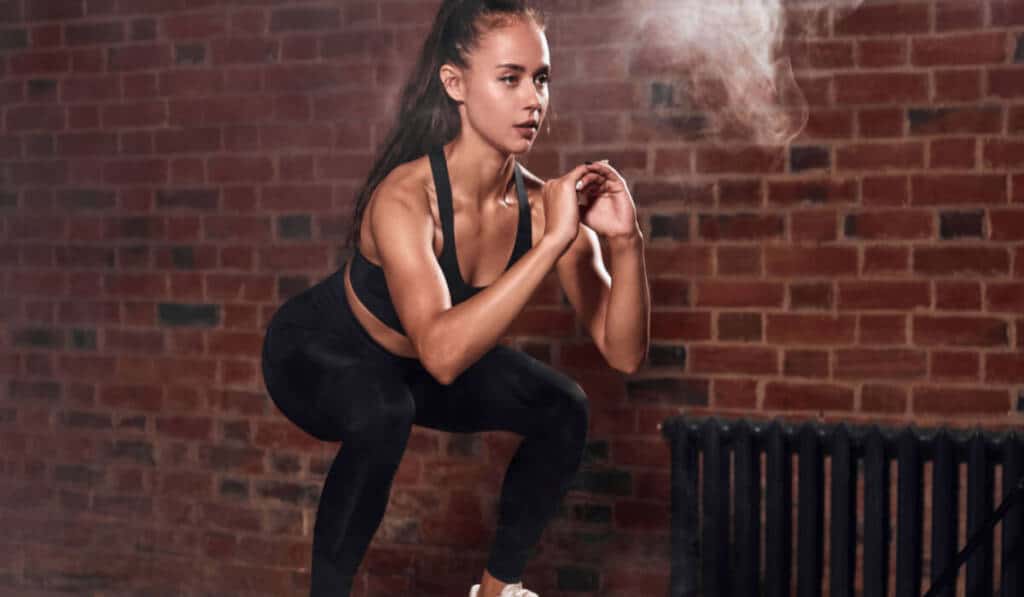
– Start by placing the feet slightly wider than hip-width and turn the toes out
– Before initiating the squat, lift the chest, pull the shoulder blades back and down and engage the core muscles
– Drop the body down through the hinging the hips and bending the knees
– Drive powerfully through the heels to propel the body back up to standing
2. Squat Jumps
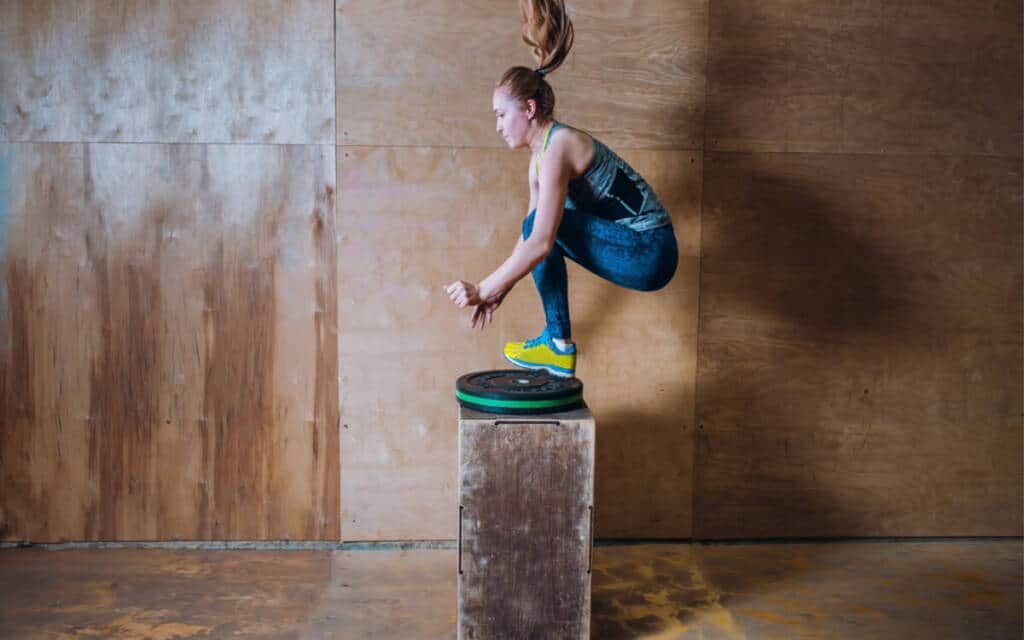
– Assume the same starting position as a conventional squat
– Drop into the squat and then quickly and powerfully drive up into a jump
– Aim to get as much height as you possibly can
– Focus on a soft landing and use the force generated from the landing to propel you into the next squat jump
3. Reverse Lunge with Knee Lift
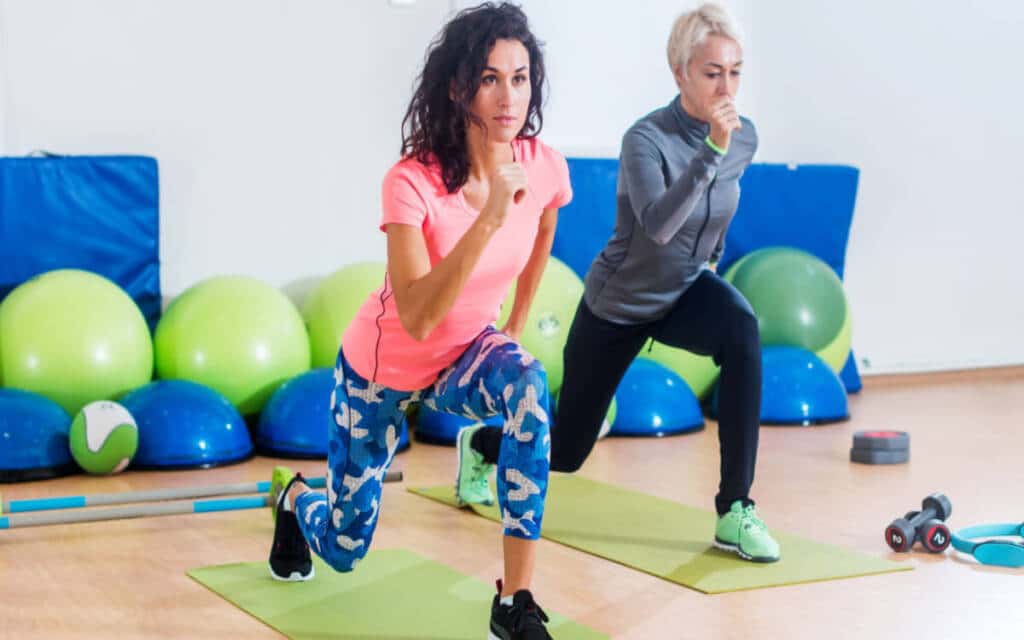
– Begin with the feet directly under the hips
– Drive the chest high, squeeze between the shoulder blades and keep the core tight
– Take a backward step and plant the foot before bending at the knees to drop the rear knee to the floor
– From this position, push hard through the heel of the front foot and simultaneous drive the rear knee up towards the chest
– Alternate between right and left side with each rep
4. Side Lunges
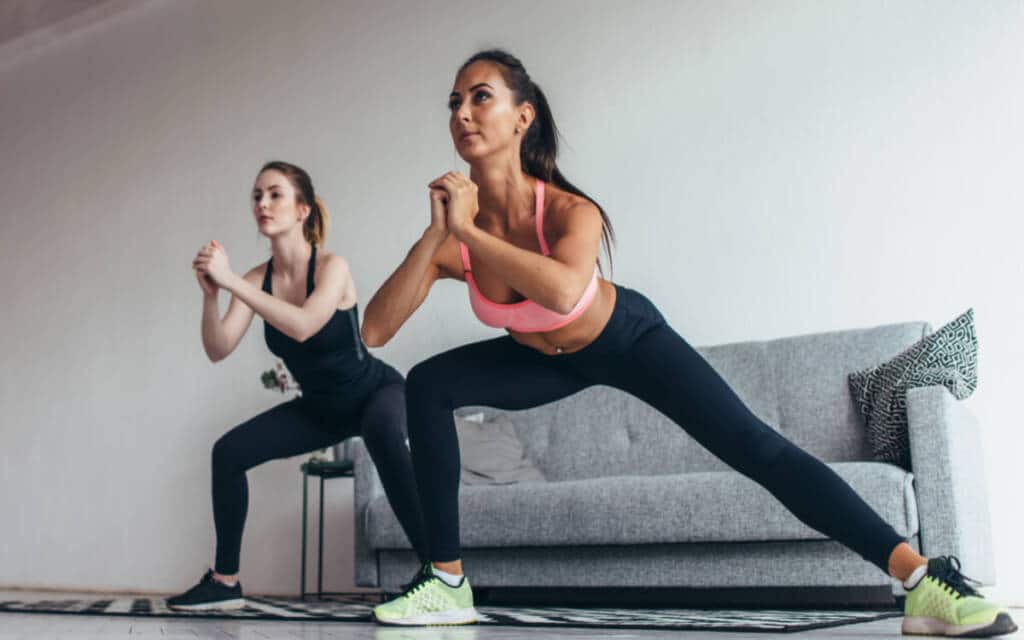
– Start with the feet underneath the hips
– Keep the chest lifted, shoulders retracted and core engaged
– Take a large sideways step and bend the knee of the leading lead while keeping the other leg straight
– Drop toward the floor before powerfully driving through the heel to return to standing and then alternate.
5. Curtsy Lunges
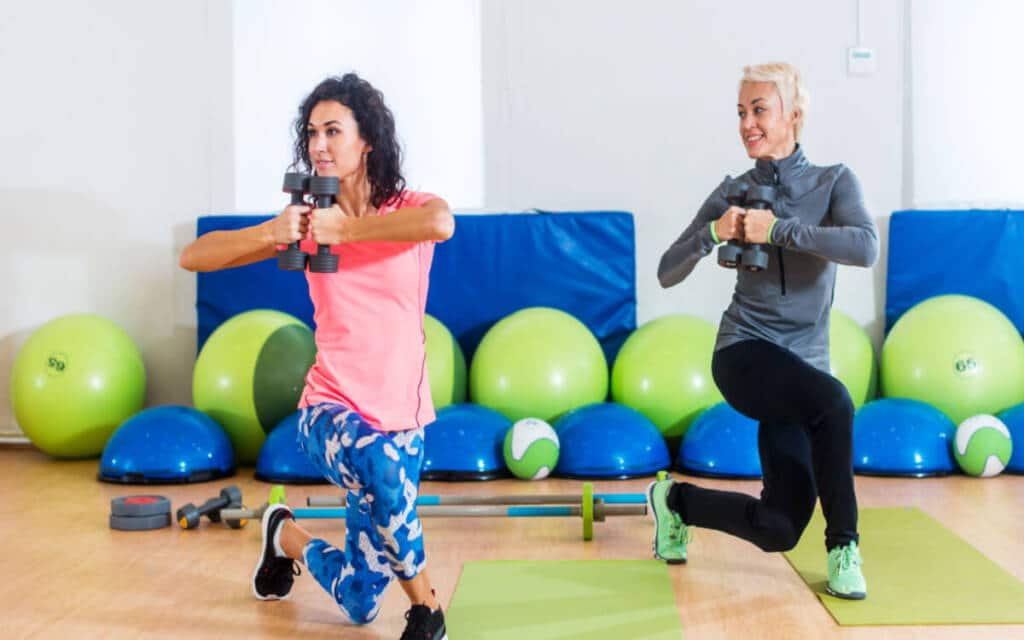
– Assume a hip-width stance, keep the chest up, squeeze between the shoulder blades and ensure that the core is tight
– Take a sideways step around the back of the standing leg and plant the foot on the floor
– Bend at the knees to drop down toward the floor before driving powerfully the heel of the planted foot
– Once you have returned to standing, alternate sides and repeat
6. Side Leg Raises
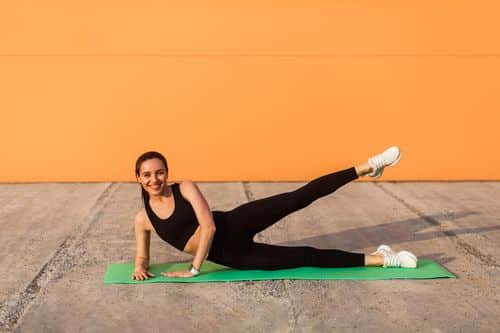
Start by lying on your side with the legs on top of each other
– From this position, while bracing the core and keeping the leg straight, lift the top leg
– Repeat for the prescribed number of reps before swapping sides and repeating
7. Hip Thrusts
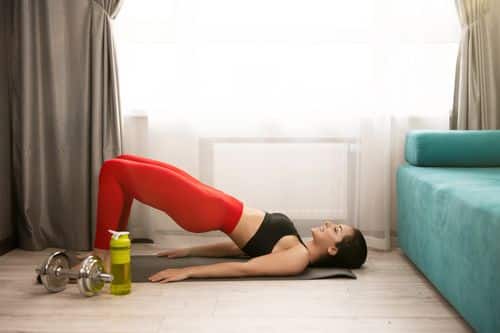
– Start in a seated position and place the upper back against an object so that the trunk is at a 45-degree angle
– Place the feet slightly wider than hip-width and ensure they stay close to the backside
– Push through the heels to drive the hips upward and contract the glutes tightly before returning to the floor
8. Single-Leg Glute Bridges
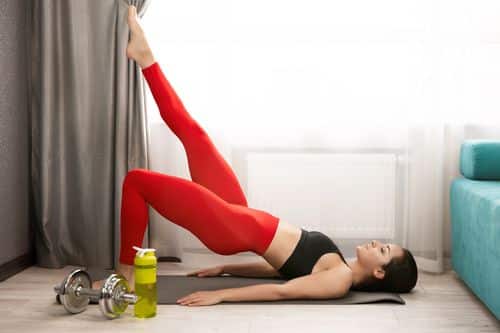
– Start by lying on the back and bring feet in close to the backside
– Engage the core muscles, lift one foot from the floor and drive through the heel of the other foot to drive the hips upward
– Control the descent and return to the floor. Complete the same number of reps on the other side.
9. Heel Kicks
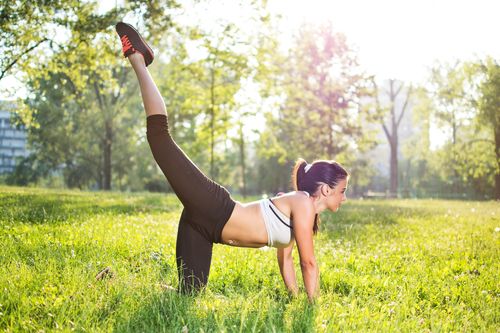
– Start in the quadruped position where both hands and knees are in contact with the floor
– Keep the core squeezed and extend one leg entirely pushing the leg behind the line of the body
– Squeeze the glute tightly at the top of the movement and return to the starting position
– Alternate sides and repeat
10. High Knee Taps
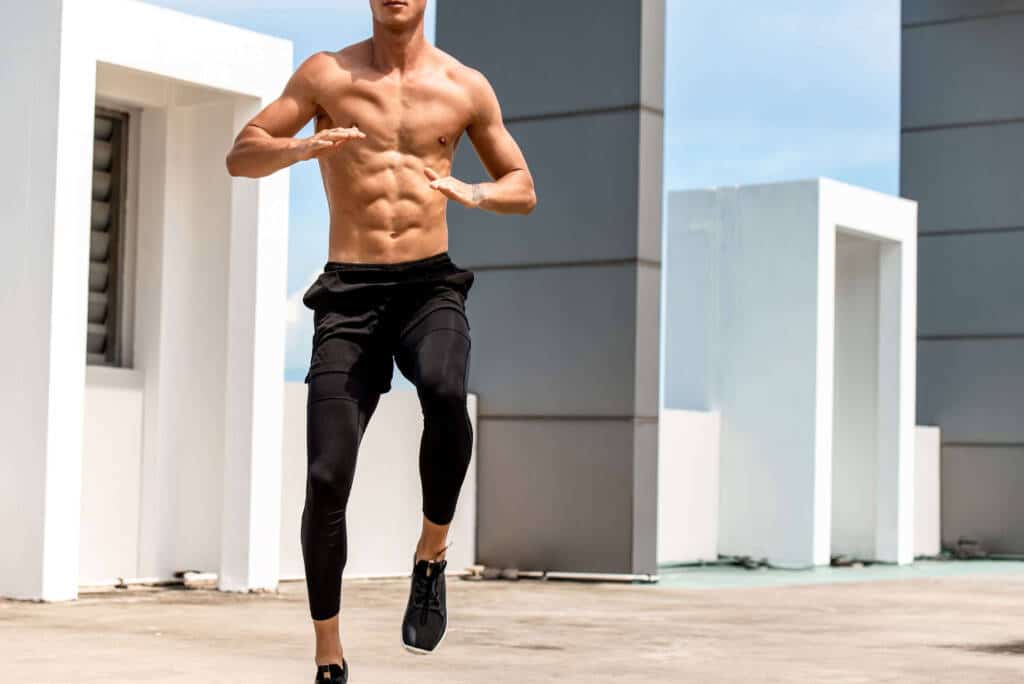
– For this exercise, start with a chair, box or bench in front of you
– Keep the chest up and core squeezed
– From this position, drive the knee up to towards the chest and place one foot up onto the object
– As soon as contact has been made, rapidly switch side
13 Leg-workout Combinations that you can try at home
1) Squat Workout
ExerciseVolume RestSquats3 sets x 15 reps60 secondsJump Squats3 sets x 15 reps60 seconds
Workout 1 utilizes the squat and squatting variations in order to develop the strength and function of the quadriceps, glutes, hamstrings, calves, and core.
2) Posterior Workout
ExerciseVolume RestHip Thrusts3 sets x 15 reps60 secondsSingle-Leg Glute Bridge3 sets x 10 reps (per leg)60 secondsHeel Kicks3 sets x 10 reps (per leg)60 seconds
The posterior workout focuses on exercises that recruit posterior chain muscles such as the glutes, hamstrings, and calves. This workout follows the same structure as the squatting workout.
3) Lunge Workout
ExerciseVolume RestReverse Lunge with Knee Lift3 sets x 15 reps60 secondsCurtsy Lunge3 sets x 15 reps60 secondsSide Lunge3 sets x 15 reps60 seconds
As with the previous two, the lunge workout uses three lunging variations to challenge the muscles of the legs and simultaneously develop proprioceptive abilities such as balance and coordination.
4) Comprehensive Leg Workout
ExerciseVolume RestSquats3 sets x 12-15 reps60 secondsHip Thrusts3 sets x 12-15 reps60 secondsSide Lunge3 sets x 12-15 reps60 seconds
Workout 4 takes one squatting exercise, one posterior exercise, and one lunging exercise to comprehensively work the muscles of the legs. Volume has been increased through an additional set and a higher number of reps to increase the challenge of this workout.
5) Plyometric Workout
ExerciseVolume RestHigh Knee Toe Taps3 sets x 12-15 reps120 secondsSquat Jumps3 sets x 12-15 reps120 secondsReverse Lunge with Knee Lift3 sets x 12-15 reps120 seconds
Plyometric exercises are often used to develop athleticism, strength, and power. The three chosen exercises should be performed in a plyometric fashion. To effectively perform these exercises, look to generate as much speed and power with each and every rep.
6) Unilateral Workout
ExerciseVolume RestSingle-Leg Glute Bridge3 sets x 6 reps (per leg)120 secondsSide Leg Raises3 sets x 6 reps (per leg)120 seconds
There is a great benefit to be found in developing single-leg strength. Not only will unilateral exercise rapidly build strength, it also helps to even out any imbalances that exist between the right and left leg.
7) As Many Reps As Possible (AMRAP)
ExerciseVolume RestHip Thrusts3 sets x 60 seconds90 secondsSquats3 sets x 60 seconds90 secondsCurtsy Lunges3 sets x 60 seconds90 secondsHigh Knee Toe Taps3 sets x 60 seconds90 seconds
There is no denying that the AMRAP workout is a challenge regardless of your level of fitness. As the name suggests, the goal is to complete as many reps as possible in a 60-second period.
8) Circuit Workout 1
ExerciseVolume RestSide Lunges30 seconds15 secondsSquat Jumps30 seconds15 secondsSingle-Leg Glute Bridge30 seconds15 seconds
Circuit training is an excellent method of training for improving all-round conditioning and specifically develops muscular strength and endurance. Simply run through exercises one to four and complete as many sets as you desire.
9) Circuit Workout 2
ExerciseVolume RestReverse Lunges with Knee Lift45 seconds20 secondsHeel Kicks45 seconds20 secondsHigh Knee Toe Taps45 seconds20 secondsSide Leg Raises45 seconds20 seconds
Circuit workout 2 is slightly more challenging as the duration of exercise is increased from 30 seconds to 45 seconds. While the rest period is increased, the total work-to-rest ratio is decreased which consequently increases the overall challenge of the workout.
10) Superset Workout 1
ExerciseVolume Resta. Squats
b. Squat Jumps3 sets of 10 – 20 reps
per exercise90 secondsa. Hip Thrusts
b. Curtsy Lunges3 sets of 10 – 20 reps
per exercise90 secondsa. Reverse Lunges with Knee Lift
b. Side Leg Raises3 sets of 10 – 20 reps
per exercise90 seconds
Supersets are simply two exercises back-to-back without any rest. For superset workout 1, complete 10 reps of both exercises A and B before resting for 90 seconds. Repeat this process for all three supersets.
11) Superset Workout 2
ExerciseVolume Resta. Jump Squats
b. Single-Leg Glute Bridge3 sets of 15 reps
per exercise90 secondsa. High Knee Toe Taps
b. Heel Kicks3 sets of 15 reps
per exercise90 secondsa. Hip Thrusts
b. Side Lunges3 sets of 15 reps
per exercise90 seconds
As with the circuit workouts, the second superset workout is slightly more demanding than the first. An additional set and a greater number of reps are performed with workout 2 in order to increase the intensity.
12) Tri-set Workout 1
ExerciseVolume Resta. Squats
b. Hip Thrust
c. Curtsy Lunge3 sets of 10 reps per exercise90 secondsa. Side Leg Raise
b. Single-Leg Glute Bridge3 sets of 10 reps per exercise90 seconds
In a similar vein to the supersets, tri-sets involve performing three exercises back-to-back with no rest between exercises. Only once all three exercises have been completed can you take a 90-second rest. The same principle should be applied to the second set of three exercises.
13) Tri-set Workout 2
ExerciseVolume Resta. Side Lunges
b. High Knee Toe Taps3 sets of 15 reps per exercise60 secondsa. Reverse Lunge with Knee Lift
b. Heel Kicks
c. Squat Jumps3 sets of 15 reps per exercise60 seconds
The final workout is an advancement on workout 12. In this instance, both the volume and rest periods have been manipulated in order to increase the demand placed on the body. As a result of this, strength levels will increase and a large number of calories will be burned.
Ideal Combinations that can be done for a Week
Workouts 1-4 have been designed to target specific muscle groups of the body and therefore can be grouped together and performed throughout the course of the week in order to onset substantial changes in leg strength.
The circuit, superset and tri-set workouts (workouts 8 – 13) can also be paired together. These workouts are excellent for those who are short of time as the structure of each workout allows you to get through a great quantity of work in a shorter time period.
Finally, the unilateral, plyometric and AMRAP workouts are stand-alone and compliment the other workouts. As a result, these three can be performed separately or alongside any of the other aforementioned workouts.
Summary
By regularly performing a selection of these workouts, significant changes will occur in terms of both the strength and function of the legs and overall conditioning. However, do not feel like you need to complete all 10 workouts, rather select ones that align with your goals, needs, and preferences.

Source by www.healthifyme.com


